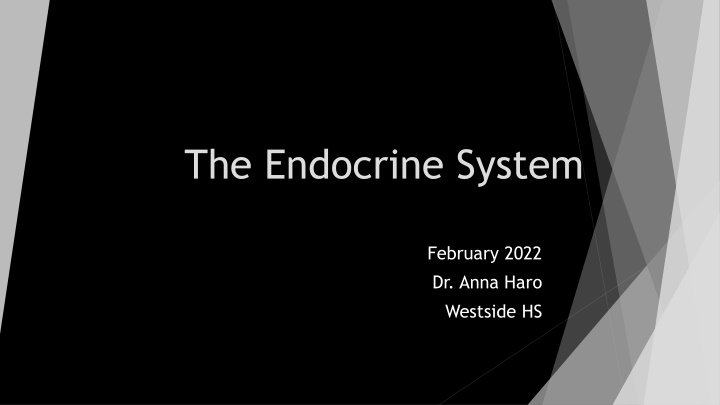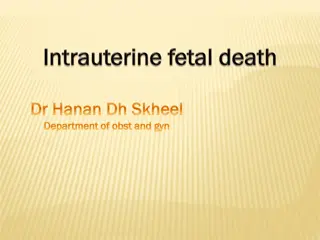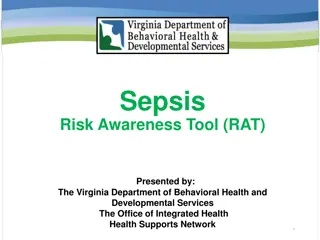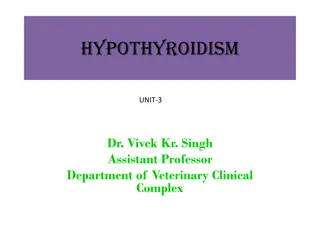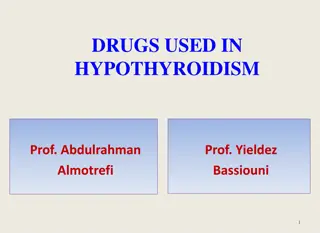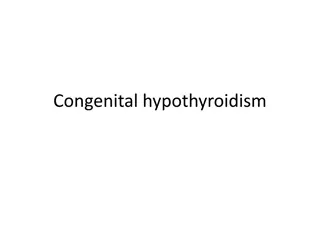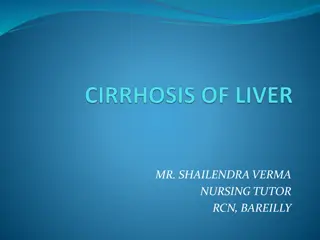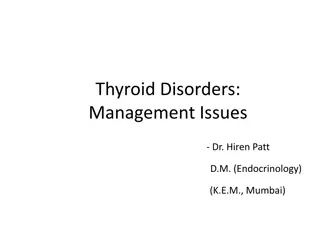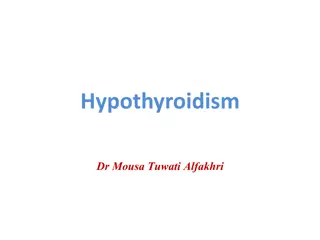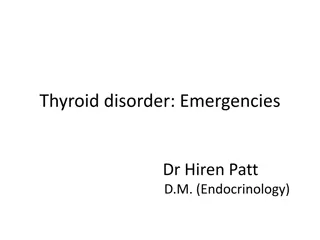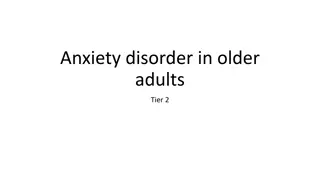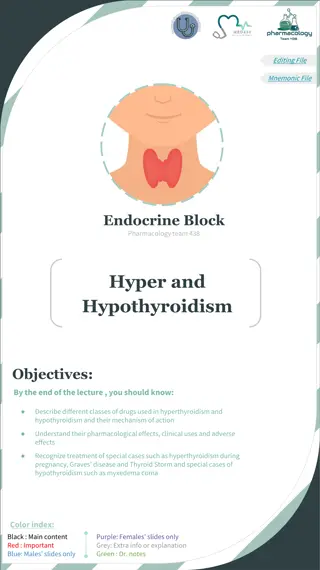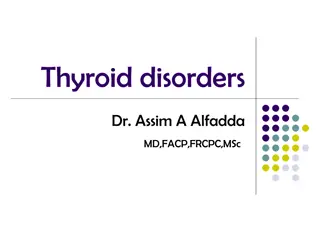Hypothyroidism: Causes, Symptoms, and Risk Factors
Hypothyroidism is a condition where the thyroid gland fails to produce enough hormones, leading to various health issues. Learn about the pathophysiology, risk factors, and treatment options associated with hypothyroidism with a focus on thyroid disorders.
Download Presentation

Please find below an Image/Link to download the presentation.
The content on the website is provided AS IS for your information and personal use only. It may not be sold, licensed, or shared on other websites without obtaining consent from the author.If you encounter any issues during the download, it is possible that the publisher has removed the file from their server.
You are allowed to download the files provided on this website for personal or commercial use, subject to the condition that they are used lawfully. All files are the property of their respective owners.
The content on the website is provided AS IS for your information and personal use only. It may not be sold, licensed, or shared on other websites without obtaining consent from the author.
E N D
Presentation Transcript
The Endocrine System February 2022 Dr. Anna Haro Westside HS
LEARNING Objectives TEKS: 130.231.(c)(1)(A, & B) and 130.231.(c)(2)(A, B, C, F, & G) & (3)(B) Students will apply knowledge of human and cellular biology. Students will apply new knowledge and skills of the endocrine system. Students will evaluate the thyroid disorders of the endocrine system. Students will identify the pathophysiology, risk factors, and treatment options for hyper- and hypo-thyroidism disorders.
Objetivos de aprendizaje TEKS: 130.231.(c)(1)(A, & B) and 130.231.(c)(2)(A, B, C, F, & G) & (3)(B) . Los estudiantes aplicar n conocimientos de biolog a humana y celular. Los estudiantes aplicar n nuevos conocimientos y habilidades del sistema endocrino. Los estudiantes evaluar n los trastornos tiroideos del sistema endocrino. Los estudiantes identificar n la fisiopatolog a, los factores de riesgo y las opciones de tratamiento para los trastornos de hipertiroidismo e hipotiroidismo.
Hypothyroidism Hypothyroidism is a condition in which the thyroid gland does not produce enough thyroid hormones. Hypothyroidism may not cause noticeable symptoms in the early stages. Over time, untreated hypothyroidism can cause a number of health problems, such as obesity, joint pain, infertility and heart disease.
Hypothyroidism - Pathophysiology Hypothyroidism results when the thyroid gland fails to produce enough hormones. Hypothyroidism may be due to a number of factors, including: Autoimmune disease. Over-response to hyperthyroidism treatment. Thyroid surgery. Radiation therapy. Medications. Ex. lithium, PTU, glucocorticoids such as prednisone or dexamethasone.
Hypothyroidism - Pathophysiology Less often, hypothyroidism may result from one of the following: Congenital disease. Pituitary disorder. Pregnancy. Iodine deficiency. The trace mineral, iodine, found primarily in seafood, seaweed, plants grown in iodine- rich soil and iodized salt, is essential for the production of thyroid hormones. Discussion: what is the role of the pituitary in regulating thyroid hormones?
Hypothyroidism Risk Factors Female, especially, older than 60 Age greater than 60 y.o. FHx of thyroid disease Comorbidity of another autoimmune disease, such as type 1 diabetes or celiac disease TX with radioactive iodine or anti-thyroid medications Radiation TX to neck or upper chest Thyroid surgery (partial thyroidectomy) Pregnant or delivered a baby within the past six months
Hypothyroidism Treatment RX levothyroxine Follow-up labs at 6-8 weeks after initiation of tx and after dose change. F/U every 6 months one stable on dose. Take on empty stomach, same time of day every day. Avoid: heavy soy or fiber consumption. Separate at least 2-3 hours: Fe or MVI with Fe, Ca, and Al(OH)3 as the cations compete for absorption in the small intestine.
Hyperthyroidism Hyperthyroidism occurs when the thyroid gland produces ____________ of the hormone thyroxine or T4. Hyperthyroidism can accelerate the body's metabolism, causing unintentional weight loss and a rapid or irregular heartbeat. Although hyperthyroidism can be serious if ignored, most people respond well once hyperthyroidism is diagnosed and treated.
Hyperthyroidism - Pathophysiology Reasons for too much thyroxine (T4): Graves' disease, an autoimmune disorder in which antibodies stimulate the thyroid to produce too much T4. (most common cause) Ophthalmopathy is the most common sx. Hyperfunctioning thyroid nodules (toxic adenoma, toxic multinodular goiter or Plummer's disease) increasing T4 secretion. Thyroiditis. Sometimes the thyroid gland can become inflamed after pregnancy, due to an autoimmune condition or for unknown reasons. Effect is over secretion of ________________.
Hyperthyroidism Risk Factors FHx of hyperthyroidism, particularly of Graves' disease Female sex A personal history of certain chronic illnesses, such as type 1 diabetes, pernicious anemia, and primary adrenal insufficiency Question: are these modifiable or non- modifiable risk factors?
Hyperthyroidism Treatment Radioactive iodine or thyroidectomy what are the complications of this tx? RX: methimazole or PTU (propylthiouriacil) Beta-blockers explain why a patient with hyperthyroidism needs a Beta-blocker. Image from: https://en.wikipedia.org/wiki/Graves%27_ophthalmopathy
What are your questions about the thyroid endocrine system disorders? Please ask, email, use Remind, or TEAMS. Remember the HON-code? https://www.hon.ch/HONcode/. Even if you cannot find the HON-code stamp, please use the principles of website evaluation. Authority, confidentiality, complementary, attribution, justification, transparency, financial disclosure, and advertising policy (HON-code, 2019).
References Shier D, Butler J, Lewis R. Hole s Human Anatomy and Physiology, 9th edition. 2003. https://www.mayoclinic.org/diseases- conditions/hypothyroidism/symptoms-causes/syc-20350284 https://www.ncbi.nlm.nih.gov/pmc/articles/PMC2784889/ https://www.mayoclinic.org/diseases- conditions/hypothyroidism/diagnosis-treatment/drc-20350289 https://www.mayoclinic.org/diseases- conditions/hyperthyroidism/symptoms-causes/syc-20373659 https://www.mayoclinic.org/diseases- conditions/hyperthyroidism/diagnosis-treatment/drc-20373665 https://en.wikipedia.org/wiki/Graves%27_ophthalmopathy DiPiro, J. (2005). Pharmacotherapy: A pathophysiological approach (6th ed.). McGraw Hill.
